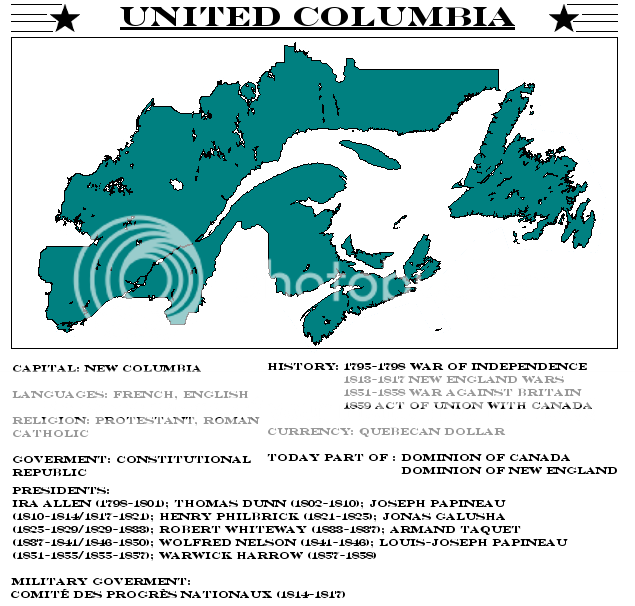United Columbia (1798 - 1859)
When Ira Allen returned from France, with the troops, material, and financial backing, he launched a successful war against the diminished British presence in Lower Canada (due to the governments decision to pull back troops to Britain, both as protection against the fledgling French republic, and to ensure domestic stability against any republican movement in the home islands). Through the years 1795-1798, Allen’s forces pushed back the diminished British garrisons along the St. Lawrence river, rallying support amongst the French Quebecois , until finally, after the siege of Quebec, Britain singed the armistice, recognizing most of Lower Canada as the new republic of United Columbia.
Following the wars end, Allen’s forces, the Green Mountain Boys (many who followed Allen to the north after Vermont’s admission into the United States), French Quebecois and those that fled tot eh banner against the British, began the task of establishing the new government, trade, and relations with the other nations. France and the US were given preferential treatment in trading with the UC, French Quebecois gained the rights they sort after in governing the territory, and together they formed one of the youngest constitutional republics in history, with Allen being elected as the first President (until his death due to lead poisoning on the 17 of August of 1801 from shrapnel remnants inside his body, leftovers from the siege of Three Rivers, the date being posthumously being honored by establish that date as the UC´s election day).
However, after Napoleons establishment of the French Empire, and his aggressive actions against its neighbors, the UC decided to begin distancing itself from France proper, resulting in the Pact of 1802, giving Britain rights to trade, giving access to the St. Lawrence river and great lake areas, moorage along Newfoundland. Eventually, during the Napoleonic wars, the UC severed all ties with France, and then, with the US (who sided with France against Britain, to diminish their presence along both the US and New France borders (the Louisiana purchase never taking place with full US entry to the war)). This angered many French nationals and Quebecois in the nation, and with the then president, Joseph Papineau advocated joining against Britain, a group of UC patriots (who also were pro-British acted by suspending the constitution (according to article 5, line 3, stating “..if foreign powers threaten the stability of the UC [and interests], both domestic and foreign, then it is the right of the governing military body to suspend the presidency, and rule in stead, until such crisis passes..”. The group suspended the Presidency, formed a wartime council, named the Committee of National Progress, and established a isolationist policy against the other powers (although they allowed British troops to pass through their borders, under the pretense of the 1802 trade act), until 1817 (this period being known today as the “New England Wars“ in North America), when the British, Austrian and allied powers defeated Napoleonic France and the US (its defeat ironically due to the UC being in exsitence, thanks to the British having sent in more troops prior to the war, originally designed to patrol the UC-British Quebec borders and trade routes: this lead to Britain reclaiming new England as far south as the Raritan River (renamed Wellington), the Michigan peninsulas, Wisconsin and all of northern New France down to the Kansas river (the entire territory being known as “New Wales”); Austria gained the southern half of New France (Spain and the Prussian Confederation being untitled to claim), eventually expending into the Texas regions; the US were forced south (the capital of Pennsylvania being leveled by British/Austrian Troops), and severely reprimanded by the winners, having to pay heavy fines, losing many of its trade ships, etc..).
Although many French nationals and republicans of the UC hated what the Committee did during its tenure, but did understand the intent: to keep the UC independent and to stop it being reabsorbed by Britain (they even managed to gain some small territory, namely in northern Vermont), and respected that it did follow the constitution and stepped down after the peace treaty of London was signed (1817). Papineau won the re-elections, and during his second term, repaired relations with many French nationals who fled to the country after the war.
During the postwar period, the UC managed to gain in power and economical might, but began to stagnate after Britain used its new Mississippi access to reroute much of their trade route to the new British Columbia colonies, although still retained the monopoly round the eastern edges. Eventually however, over the next few years, French nationalism once again arose against the pro-British governments during this period, especially with the restoration of the Second Napoleonic Empire, until, in 1950, Louis-Joseph Papineau won on a anti-British/Germanic platform. As soon as he came to power, he and his allies in the military seized control of the Senate, and forced through the Quebec reforms, allowing the President greater power over all branches of the government, arresting any who stood against him (even those who supported him, like the Quebec Republican Party). Eventually the UC, under Louis-Josephs government, entered the war on the side of France (and aided in part by the US, who were at the time, conducting their own war against Austria for control of Louisiana, and secretly, Russia, who wanted Russian Alaska back after the British took it in 1827), breaking much of the British defense in New England, and during the war, expanding the UC´s holdings over the entirety of British Quebec, Labrador, everything north and east of the Hudson rive line, and even laying siege to Ottawa and New London. Although the UC´s forces progressed rapidly in the beginning years of the war, by 1854 their offensive had become stagnated, especially with the loss of US troops and materials (after its defeat in the battle of Meridan), and greater British/Germanic troop reinforcements in the north. The British/Germanic alliance eventually pushed the UC forces back, and in 1856, after the loss of French forces with the end of the Second Napoleonic wars (with the execution of Napoleon III), and the death of Louis-Joseph and the majority of his cabinets death on the 23rd of February 1857 during the British offensive into the capital of New Columbia (Louis-Joseph refused to evacuate the city until the last moment, dieing with the vice-president, speaker of the house and high ranking officials and generals when the Senate house was shelled by mortars).
Two days later, Warwick Harrow (the then Secretary of Trade, who was one of the longest advocates of the anti-war movement a the time) was sworn in as the last President of the UC. In late April of 1858, he signed a armistice with the British/Germanic forces, ending the war in the north. 3 weeks later, in New York, he, along with other UC prominent members, signed the peace treaty of 1858, ending the UC as a independent state, and allowing it to be reabsorbed into British Canada, first as a transition Republic (with Harrow remaining as head of state , filling out the rest of Papineau´s term for that year), until January 1st, 1859, when the Act of Union with Canada came into effect, ending United Columbia as a nation.
However, the UC left a large impact over modern Canadian history, including the recognition of a Francophile state inside Canada, which was formalized during the Act of Confederation (20th of June 1870) which created the Dominion of Canada (with the Dominion of New England & Dakota Republic a few years later), and established the Province of Quebec-Columbia, even keeping the UC´s Flag as its own (although changing the top left and bottom right star to fleur de lis) and the use of many of its articles and amendments from its constitution influencing policies by foreign nations, during and after its disbandment as a nation, such as: the abolition of slavery (1804), its 3rd amendment (1807), protecting national parks and the enviroment (by severly regulating logging and land rights), complete male suffrage (from the age of 21) regardless of class (1798), the act of free religion and tradition (1800), allowing all religion and their traditions so long as they dont go against constitutional and state law (greatly protecting the native american way of life), for a few examples.
Flag of United Columbia (1798-1858):
Wikiesque map and details of United Columbia:
No, I just came up with the whole design and story tonight. Normally I just concentrate on the flag design and less on the background-story, but today it was the other way around as you can see. The flag is rather simple and the background I gave more attention and I must say it was fun writing it, although I don't know if the background-story makes any sense, maybe I just wanted to make a "Great-Suriname" story




